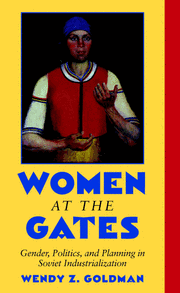Book contents
- Frontmatter
- Contents
- Acknowledgments
- List of Illustrations
- List of Tables
- Acronyms and Abbreviations
- Women at the Gates
- Introduction
- 1 Guarding the Gates to the Working Class: Women in Industry, 1917–1929
- 2 The Struggle over Working-Class Feminism
- 3 The Gates Come Tumbling Down
- 4 From Exclusion to Recruitment
- 5 “The Five-Year Plan for Women”: Planning Above, Counterplanning Below
- 6 Planning and Chaos: The Struggle for Control
- 7 Gender Relations in Industry: Voices from the Point of Production
- 8 Rebuilding the Gates to the Working Class
- Conclusion
- Index
- Plate Section
6 - Planning and Chaos: The Struggle for Control
Published online by Cambridge University Press: 30 July 2009
- Frontmatter
- Contents
- Acknowledgments
- List of Illustrations
- List of Tables
- Acronyms and Abbreviations
- Women at the Gates
- Introduction
- 1 Guarding the Gates to the Working Class: Women in Industry, 1917–1929
- 2 The Struggle over Working-Class Feminism
- 3 The Gates Come Tumbling Down
- 4 From Exclusion to Recruitment
- 5 “The Five-Year Plan for Women”: Planning Above, Counterplanning Below
- 6 Planning and Chaos: The Struggle for Control
- 7 Gender Relations in Industry: Voices from the Point of Production
- 8 Rebuilding the Gates to the Working Class
- Conclusion
- Index
- Plate Section
Summary
We have, even now, no methodology for accounting for women or calculating the demand for them.
G. Ritov, labor expert, summer 1931There is no system and no plan. Work proceeds samotek.
Safina, Department for Mass Campaigns, VTsSPS, fall 1931In the Leningrad electrical factory, Elektroapparat, the “door to the production shop was closed to women.” They could always be found outdoors, however, hauling heavy loads in the freezing, dirty yard that surrounded the factory. Male workers joked that the yard was “the women's shop.”
Reporter, 1931By the beginning of 1931, the state had developed extensive plans for involving women in the labor force. NKT (the Commissariat of Labor) and Gosplan had drafted a five-year plan for female labor, the Party had launched a campaign to employ 1.6 million women, the government had published long lists of jobs reserved primarily or exclusively for women, and women's brigades had visited factories throughout the country to determine which jobs women could fill. Yet all of these plans, lists, and recommendations still existed only on paper. For the central authorities and KUTB (the Committee to Improve the Labor and Life of Women), the key question in 1931 was how to move plans from paper to reality.
- Type
- Chapter
- Information
- Women at the GatesGender and Industry in Stalin's Russia, pp. 179 - 206Publisher: Cambridge University PressPrint publication year: 2002



